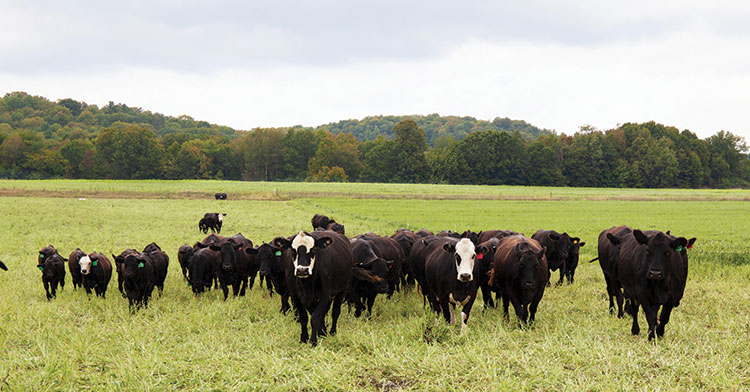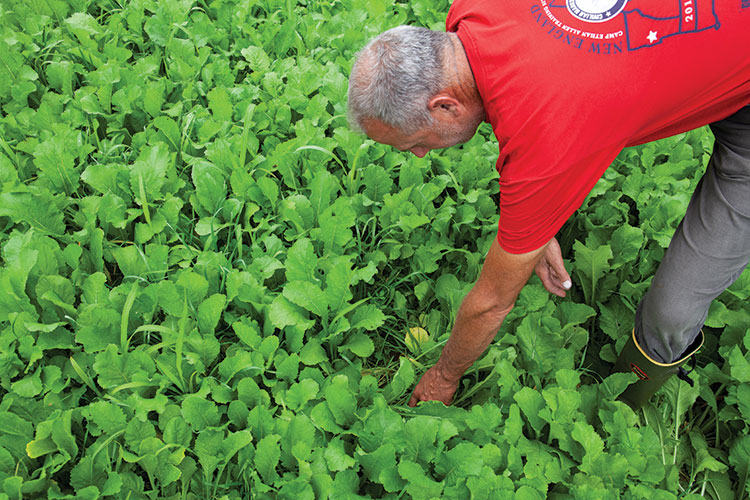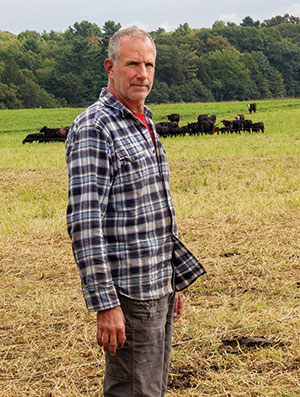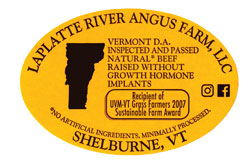
John Kleptz is a mechanic, rotational grazer, forage producer, electrician, cattleman, meat processor, public relations director, welder, delivery truck driver, construction supervisor, and competitive sharpshooter. That latter skill was honed while serving a stint in the Marine Corps. Most of his other résumé-building talents he directly attributes to his dad’s tutelage.
John talked with a low, matter-of-fact tone in the office of Bear Trap Custom Processing, the final stop before his beef cattle enter the consumer end of the food chain. How he got here in Milton, Vt., is a long story that begins in Indiana with his father, Jim.
“My dad was one of six children in Terre Haute, Ind., and raised during the Great Depression,” John said. He joined the Air Force, served in the Korean War, and eventually found himself working as a mechanical and electrical engineer for General Electric (GE). That job would eventually get him transferred to GE’s plant in Burlington, Vt.
The move to Vermont came in 1971. The family consisted of John, his parents, and four other siblings (two brothers and two sisters). Jim purchased a 10-acre hobby farm in Shelburne, Vt., in 1973 where his family could live.
A hobby gone wild
“Though not raised on a farm, my dad always had this passion for Black Angus cattle,” John explained. “We started with a few head and then the herd grew; it was more or less a hobby that simply spiraled out of control. Before long, we had 30 to 40 head. My brother, Mark, had been working on some local dairy farms, and I went off to the Marine Corps after high school. My dad still worked for GE, and he finally gave us an ultimatum that he needed help with the cattle, or they would have to go because they were too much of a financial and labor burden.”
In 1980, the older Mark began to work full time with the family beef business — coined LaPlatte River Angus Farm. John joined his father and brother on the family farm in 1988 after his time in the Marine Corps.
It wasn’t commonplace back then to direct-market beef, but that’s what the Kleptzes did from the start. John and his father essentially became door-to-door salesmen for beef.
“Our meat processing was done at other facilities, and I got some experience with marketing and at processing plants during the mid-1990s,” John explained. “We operated out of a couple of rented facilities for a while, and when we lost the last one, I told my father and brother that we needed something permanent.”
They bought the 208-acre Milton farm in 2011. It was a former dairy farm, located about 23 miles north of the home farm in Shelburne. “We came to this location because of the sandy soils, which made it easier to get wastewater permits for the future processing facility,” John noted.
John and his father went to work designing the processing facility. “When it came to mathematics and engineering, my father could figure anything out,” the appreciative son said.
Multiple nights were spent determining what construction materials would be needed and how they would fit together. By this time, Jim was also battling leukemia. John started building the meat processing facility in 2013, welding all the steel support frames together himself.
Bear Trap Custom Processing began operations in May 2015. Jim passed away in October 2015 at the age of 83.
Back to the present
These days, LaPlatte River Angus Farm operates from the Shelburne and Milton locations. John and Mark are equal ownership partners. Helping Mark in Shelburne is another brother, Chris, and a nephew, Jim. The original southern location has about 70 brood cows and consists of about 500 acres (owned and rented) of pasture and hayfields.
In Milton, there are the original purchased acres and another 70 that are leased. John and his son, Ben, manage the operation. Four full-time employees work in the meat processing plant. John also oversees 35 to 40 brood cows and both his own stocker cattle along with those that he purchases from neighbors each year.
John’s wife, Jean, and Mark’s wife, Joan, assist with the overall operation by managing the record books.
Multiple forage options

Surrounding the main buildings at the Milton location are pastures of every ilk. “I try to do something different every year,” John noted.
His base perennial pastures consist of alfalfa and tall fescue, which he reseeds every six to seven years. His rented pastures and hayfields are a mixture of cool-season species that include orchardgrass, timothy, and smooth bromegrass.
“We’re big believers in rotational and strip grazing, and every pasture, regardless if it’s a perennial or annual, is managed that way,” John asserted. “I know it’s good for the land, it’s good for the cattle, and it’s good for the person managing the cattle because they’re forced to spend time with the animals. In our case, we also get a lot of exercise because we don’t own an ATV (all-terrain vehicle), so we walk everywhere,” he added.

Seeking to maximize gain on his forage base, John moves his cattle every day. Depending on the season, he allots just enough forage for one day using polywire and fiberglass posts. Not surprisingly, his belief in rotational grazing initiates from his father. Many years ago, after reading about rotational grazing in three or four magazines, Jim ordered electric fencing from Texas because it wasn’t sold in Vermont at the time.
John said he likes to experiment with new species, always in search of something better. Although he has had good success with brown midrib (BMR) sudangrass, this past year he also tried seeding some pearl millet and kale to help supplement his perennial pastures during the dry summer slump, which is amplified on the sandy soils. “In the past, I loved sudangrass, but when you get into the second round of growth and frost becomes a concern, then we worry about prussic acid being a problem.”
In late-summer 2019, John seeded a new pasture with a mixture of chicory, alfalfa, subterranean clover, tall fescue, and orchardgrass. It had yet to be grazed as of mid-September but looked exceptional.
A need for stored feed
Being in the far reaches of northern Vermont, grazing year-round is not an option. To keep adequate gains on stocker calves through the winter, John must depend on stored feed.
His storage method of choice is silo bags. He fills seven to nine 8- by 150-foot bags each year. Included in the stored feed inventory is corn silage and haylage. John also chops winter wheat, spring barley, and spring-planted oats and peas, which he really likes.
Most of the haylage is made early in the growing season on dedicated, rented hay fields. Once mid-July rolls around, he shifts to making dry round bales, putting up 300 to 350 bales per year to help carry his brood cows through the winter.
A competitive market
“We try to utilize our pastures and stored forage to their fullest potential and then finish cattle on corn toward the end,” John said. Cattle are finished on a total mixed ration (TMR) consisting of corn silage, dry shelled corn that is run through a grinder-mixer, and minerals. The finishing period ranges from 90 to 130 days, depending on the animal.
Bear Trap Custom Processing slaughters 650 to 780 head per year. Custom processing for other producers accounts for about 30% of their business. All of the meat is sold wholesale, and they currently have 38 regular businesses that they supply with beef. John and his son make all the meat deliveries, which gives them a chance to interact personally with their clientele.

Even with the competition, LaPlatte River Angus Farm continues to grow, improve, and bring in a third generation. John didn’t hesitate when asked how they have been able to make such great strides in such a short amount of time. Although a well-planned grazing and forage program certainly deserves some of the credit, he attributes most of their success to Jim Kleptz.
“My brother and I have to give our father a lot of credit for where we are today,” John said. “He read every agricultural magazine that existed. He talked to everybody who had knowledge of agriculture. He even took classes at night where he learned about production practices, genetics, and how to A.I. cows. He just had a thirst for knowledge that he passed along to his kids. He also had a deep appreciation in the environment and water quality in Vermont and instilled that in us as well,” he concluded gratefully.
This article appeared in the February 2020 issue of Hay & Forage Grower on pages 8 to 10.
Not a subscriber? Click to get the print magazine.

